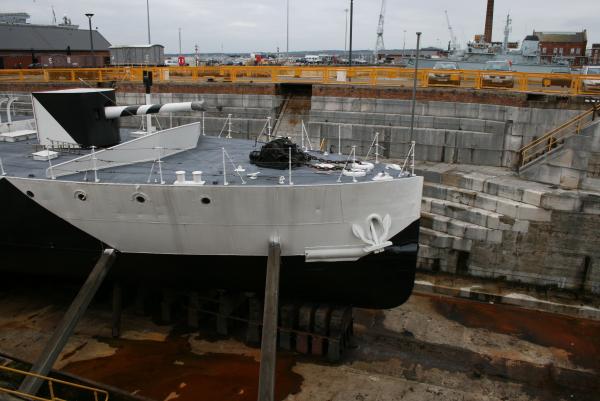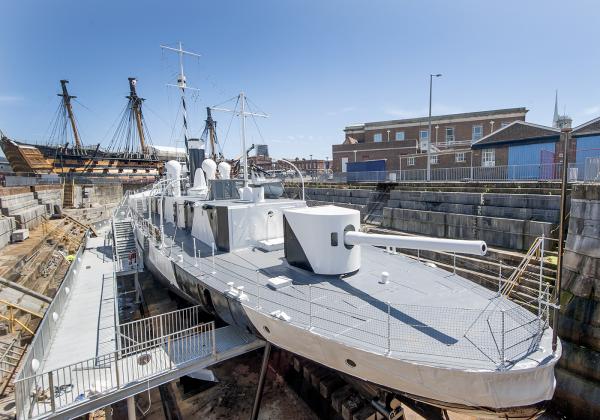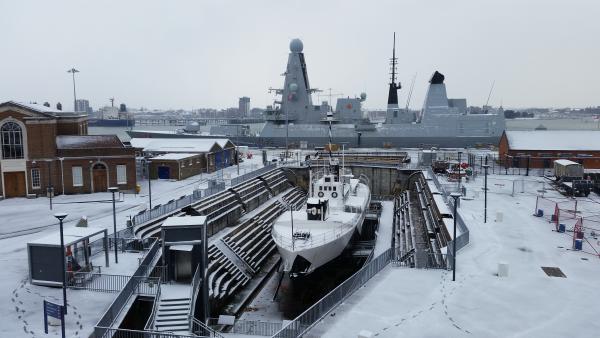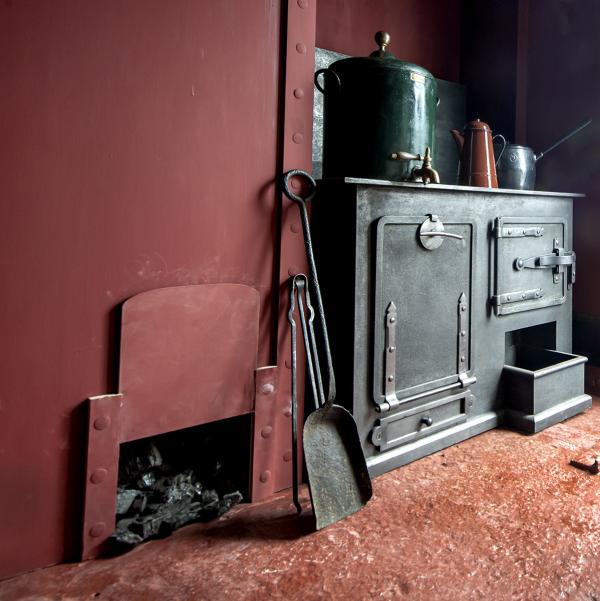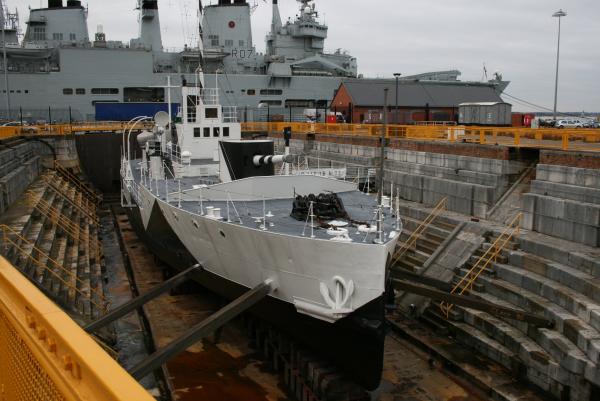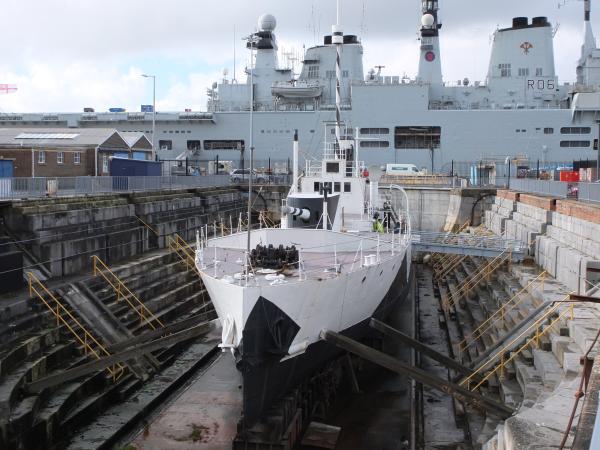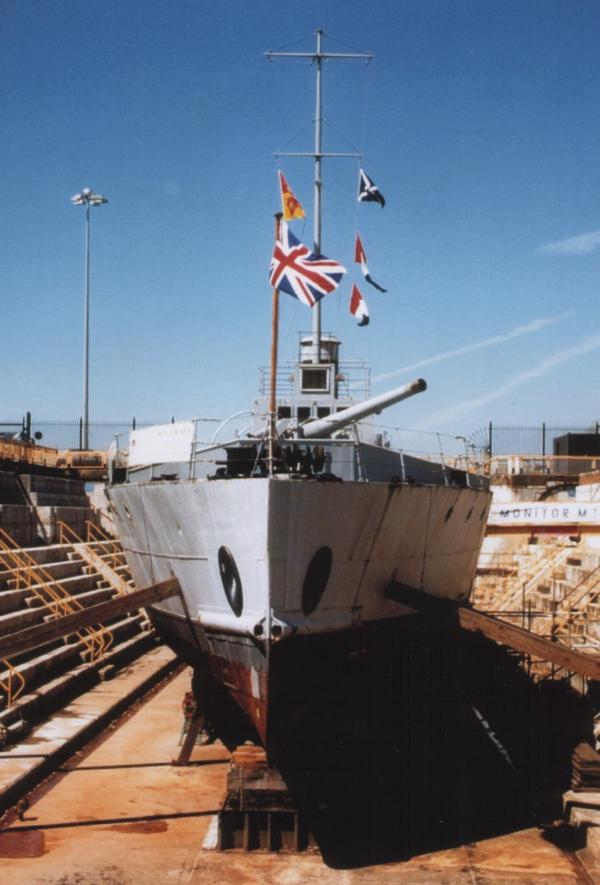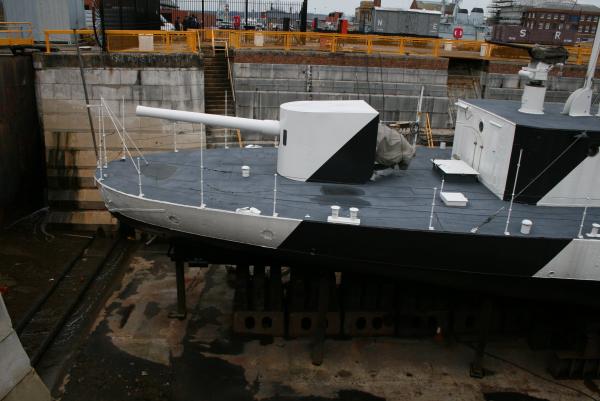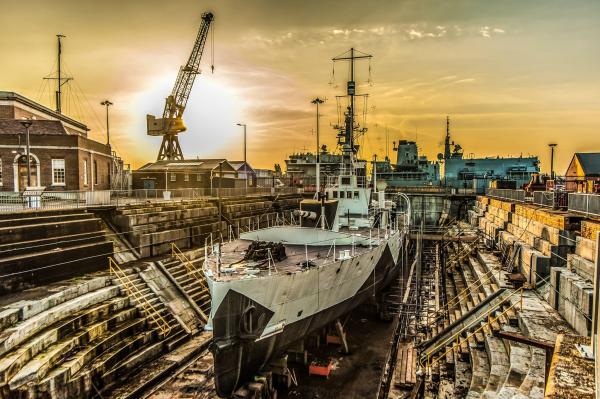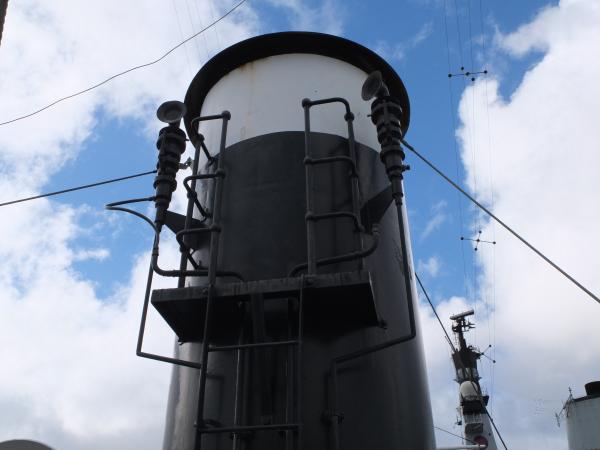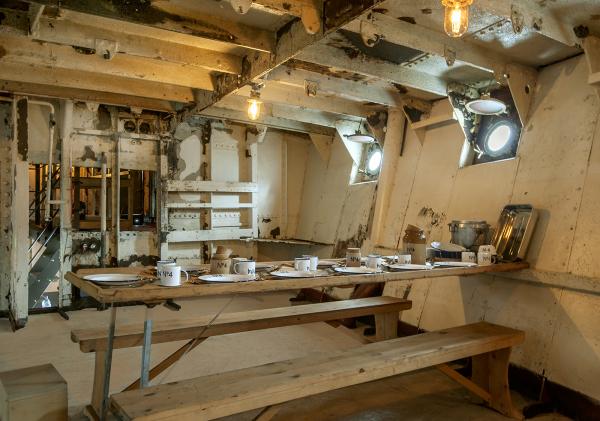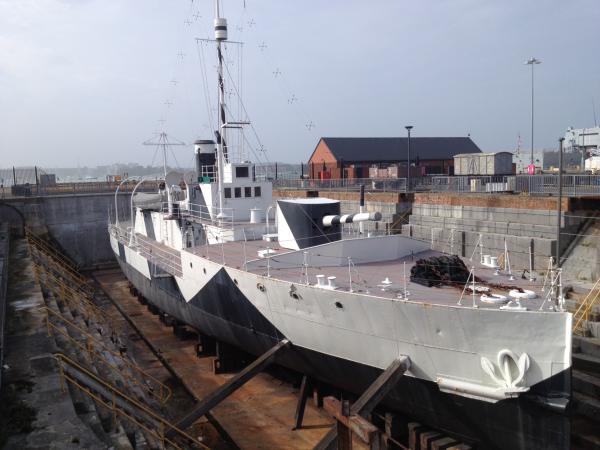

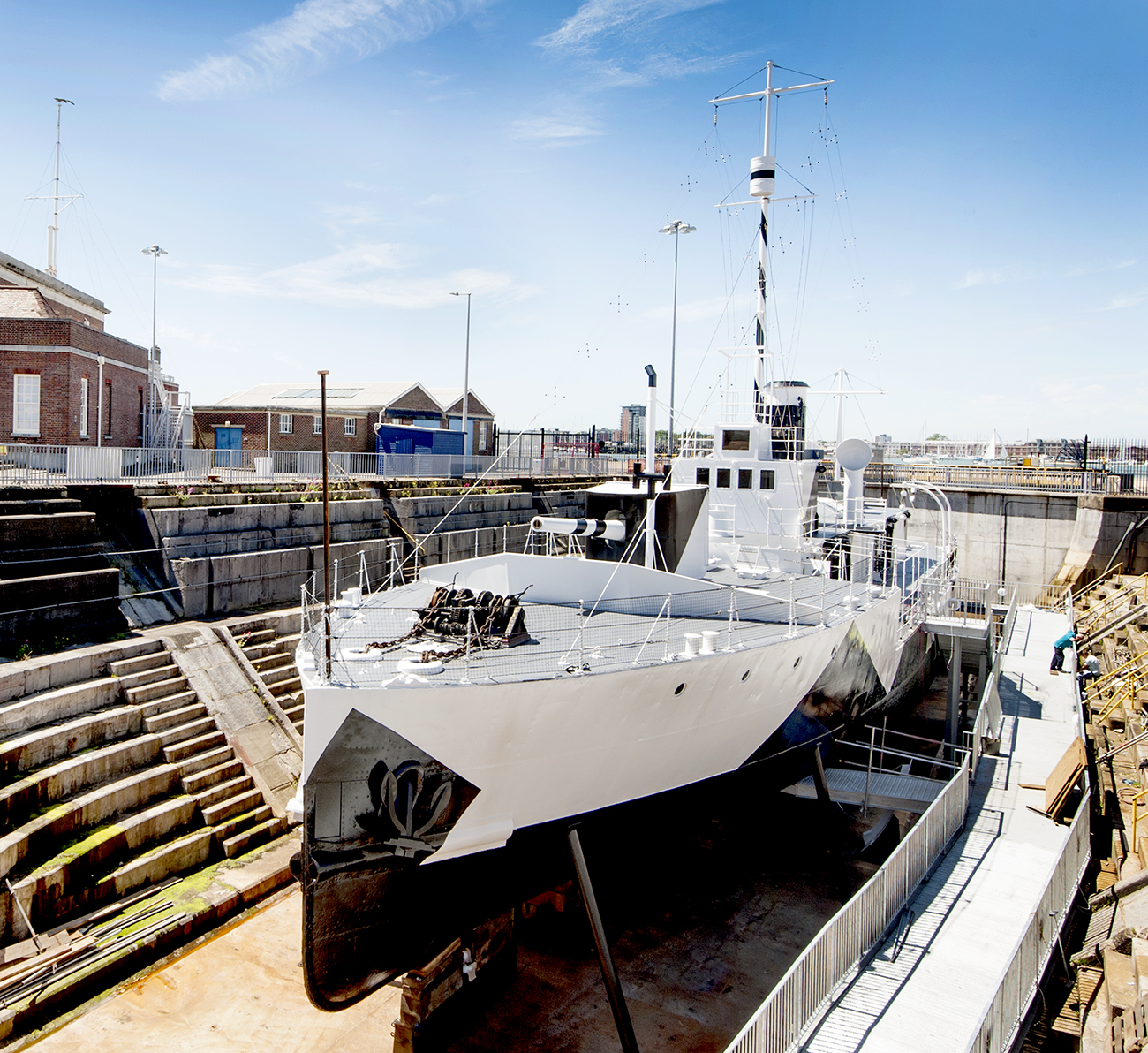
Previous names
- 1915 - 1924 M33
- 1925 - 1939 HMS Minerva
- 1939 - 1945 C23(M)
- 1945 RMAS MINERVA
Details
Construction
Dimensions
History
In 1914, the Royal Navy embarked on an expansive programme of warship construction, including a fleet of low freeboard, coastal bombardment vessels called monitors. M33 was one of a new class of particularly shallow draft monitors, designed in 1915 once it was found that the four secondary 6-inch guns on the new QUEEN ELIZABETH class of battleships were too close to the deep waterline to be worked effectively in a seaway. Two of these guns in each of the 5 ships in this class were re-sited, but the other two were removed completely and mounted on the new monitors, ordered from Harland and Wolff, Belfast, on 15 March 1915.
Both M32 and M33 were sub-contracted to the neighbouring yard of Workman Clarke and Co., Ltd., where they were laid down on 1 April 1915 and launched on 22 May 1915. Fitted with a pair of steam reciprocating engines capable of running at 9.6 knots, M33 commissioned at Belfast on 17 June 1915 and, after certain technical difficulties relating to her freeboard and trim, which were overcome by an extra four tons of permanent ballast aft, she was accepted from the builders, on 24 June.
With five officers and 67 hands, M33 under the command of Lieutenant Commander QB Preston Thomas RN, sailed for the Dardanelles, arriving at the end of July 1915. She gave support at the Suvla landings in August and continued to assist there for the remainder of the Gallipoli Campaign, until she was ordered to Salonika in January 1916 to support the Allied flank against the Bulgarians. Until almost the end of the war, M33 then operated with the several Detached Squadrons in the central Aegean, where her duties included bombardment of the Turkish coast, blockade, control of shipping and general patrol work, before returning briefly to Salonika.
M33 paid off at Mudros on 10 January 1919 with the reputation of being a “lucky” ship. Early in 1919, she went home to be adapted for service with the White Sea Squadron. She sailed for North Russia on 12 May 1919, arriving at Archangel in June under the command of Lieutenant Commander K Mitchell RN. She was immediately ordered to the River Dvina to help the British and other ground troops fighting in support of the counter-revolutionary forces in their war against the Bolsheviks. Her shallow draft and relatively heavy armament proved invaluable both then and in the subsequent Allied withdrawal in September 1919. On her return to England, M33 was laid up at the Nore until 1924 when she was converted for mine-laying duties at Pembroke. Re-commissioned on 3 February 1925 and renamed HMS MINERVA, she became a tender at HMS VERNON, the Portsmouth school of torpedo and anti-submarine warfare.
In 1939, she was converted to a boom defence workshop, designated C23(M), and towed to the Clyde. Returning to the Solent post-war, she remained a floating workshop and office, based at Royal Clarence Yard in Gosport, with her name changed once more to RMAS MINERVA. In 1987 she was disposed of and taken to Hartlepool for restoration. She was then acquired by Hampshire County Council in recognition of her outstanding combat history and as one of only two surviving naval vessels of World War One. In April 1997, bearing her old name M33, she was placed in No 1 Dock in HM Naval Base, Portsmouth, to facilitate the vital scientific conservation work on her still largely original shell plating. Much of this has now been accomplished with considerable progress made in returning most of her upper deck arrangements and superstructure to their external configuration and appearance circa 1915-1919; both six-inch guns have been re-instated and new timber masts from the conservation workshops at Merseyside Maritime Museum fitted.
In 2007, her hull, funnel and upperworks were re-painted in her First World War livery.
M33 occupies a prominent position adjacent to HMS VICTORY.
This vessel is a survivor from the First World War. You can read more about her wartime history by visiting our First World War: Britain's Surviving Vessels website www.ww1britainssurvivingvessels.org.uk.
Source; Campbell McMurray, Advisory Committee, March 2009.
Significance
1. What is the vessel’s ability to demonstrate history in her physical fabric?
Evidence for designs, functions, techniques, processes, styles, customs and habits or uses and associations in relation to events and people. How early, intact or rare these features are may impact on significance.
M33 was one of nearly 40 Monitors built following the outbreak of the First World War. She was designed as a floating gun platform, and was fabricated in just seven weeks. She is flat-bottomed with a draught of less than 6 feet, and so could be risked close inshore. She was powered by a twin screw triple expansion 400hp engine, and had a top speed of less than 10 knots. She carried two 6 inch guns, situated forward and aft, a single 6 pounder Hotchkiss gun and two Maxim machine guns.
After the end of the First World War M33 was used for a variety of purposes. In 1919 she became a tender, and in 1925 was converted into a minelaying training ship. She was later used as a fuelling hulk, and in 1943 her engines and boiler were removed when she was converted to a boom defence workshop. After the end of the Second World War she became a floating workshop and office for local Fleet Auxiliary craft.
Her funnel was restored in 1987, and in 1991 her forward gun was installed. In 2007 she was repainted in the black and white anti-submarine dazzle camouflage she wore in 1918. She underwent an extensive programme of conservation in 2014/15. The original steelwork was consolidated and conserved so as to expose original features. Later layers of paint were stripped back exposing the authentic and cracked paint surface below, which were then coated with protective wax. Fittings including the mast, boat, gun shields for the 6 inch and 6 pounder guns were restored and refitted.
2. What are the vessel’s associational links for which there is no physical evidence?
Associations with people or places. Off-ship research.
Evidence exists to suggest that the smaller 6-inch gun monitors began life as a rough sketch drawn by the then Director of Naval Construction, Sir Eustace Tennyson d’Eyncourt, during a meeting with Sir Winston Churchill, First Lord of the Admiralty and Admiral Sir Jacky Fisher, First Sea Lord, in March 1915. The basic design for the larger monitors was largely carried out by Charles Lillicrap, who also seems to have taken over the design of the smaller vessels, and he too went on to become Director of Naval Construction (1944-1951). Monitors thus had a very distinguished lineage.
M33 is one of only three surviving warships of the First World War (the others are HMS Caroline and HMS President). She played an important role in the Gallipoli Campaign. She and some of her sister ships arrived in the Aegean Sea in time to help cover the landing of reinforcements along the southern coast of the Peninsula during August 1915. She was later involved in the evacuation of troop, assisting the army in establishing a base at Stavros in January 1916. She continued to serve in the region before her return to England in April 1919. She was recommissioned and sent to North Russia in May 1919 with the British Relief Force to cover the withdrawal of Allied and White Russian troops, as part of the Dvina River Campaign. M33 with other vessels bombarded Bolshevik positions along the river.
Her distinguished record of service at Gallipoli gives M33 great national and international significance. Her uniqueness and her career between 1915 and 1919, the significant period of her life and history, provide rich opportunities for both the interpretation of a distinctive aspect of the operational history of the Royal Navy in the First World War, and more widely for the education and greater public understanding of the economic, social and geo-political context within which the history and experience of citizens of the twentieth century were in large part shaped.
In view of her record of survival virtually unscathed in circumstances where so many other ships were badly damaged or destroyed, M33 won the reputation of being a “lucky” ship which she retained throughout her active service life.
M33 relieved more versatile ships like destroyers for deployment in more active roles. Lessons learned from the experience of the monitors in all theatres of war drove many of the advances in long-range naval gunnery later applied to the battle fleet.
3. How does the vessel’s shape or form combine and contribute to her function?
Overall aesthetic impact of the vessel, her lines, material she was built from and her setting. Does she remain in her working environment?
Being a steel-built, steam-driven hull of simple form and construction M33 does not embody any important technological innovation or other distinctive nautical feature. She is not a particularly significant artefact in terms of naval architecture or ship construction, but in her relative ordinariness she is an important representative of the smaller type of naval vessel generally employed for workaday purposes in war-time.
M33 is positioned in the No.1 Dry Dock at Portsmouth Historic Dockyard built in 1801 alongside HMS Victory, where she serves as a static museum. Internal exhibits include an immersive battle experience and a digital projection of the Gallipoli Campaign. She is fully accessible to the public.
Source: NHS-UK team, 11 August 2015.
This statement was developed as part of the Heritage Lottery funded First World War project. http://www.ww1britainssurvivingvessels.org.uk/
Key dates
- March 1915 Laid down in yard of Workman, Clarke & Co Ltd, Belfast
- May 1915 Launched
- July 1915 Commissioned and sailed for Aegean and the Gallipoli Campaign
- January 1919 Paid off, repaired and refitted
- May 1919 Joined White Sea Squadron and sailed for Dvina River, North Russia
- September 1919 Returned to England, paid off and laid up at the Nore
- 1924 Taken to Pembroke Dockyard for conversion to mine-laying duties
- February 1925 Re-commissioned, re-named HMS MINERVA, tender to HMS VERNON
- 1939 Floating boom defence vessel, towed to River Clyde, re-named C23(M)
- 1945 Returned to Portsmouth, re-named RMAS MINERVA, a floating workshop
-
1987
Disposed of and transported to Hartlepool for restoration
- 1990 Acquired by Hampshire County Council, the ship is returned to Portsmouth where she becomes M33 again
-
2007
Vessel 2007 repainting add “also known as dazzle style”
-
2013
Awarded a grant by the Heritage Lottery Fund. Restoration project begins
-
2015
Following £2.8m restoration project, HMS M33 opens to the public as new visitor attraction
Grants
-
2013-14
The Heritage Lottery Fund awarded £1,799,000 for the 'Commemorating Gallipoli 1915' project
Sources
Heritage Microbiology and Science: Microbes, Monuments and Maritime, RSC Publishing
Brouwer, Norman J, International Register of Historic Ships, Anthony Nelson, pp163, Edition 2, 1993
Schleihauf, Bill, Warship International The restoration of M33, 2000
Sea Breezes: Credit where its due, pp163, Edition 2, 1993
Stephens, Avril, The News: Ship survives battles to be hit by weather, 15 February 1997
Bettsworth, Richard, The News, Portsmouth: Ship to be flooded for her own good, pp31, 2 April, 1998
Bettsworth, Richard, The News, Portsmouth: New Milestones in Warship's Slow Journey, pp11, 25 July, 1996
Own this vessel?
If you are the owner of this vessel and would like to provide more details or updated information, please contact info@nationalhistoricships.org.uk

